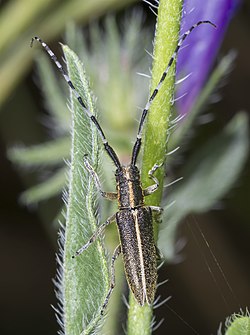| Agapanthia cardui | |
|---|---|
 | |
| Scientific classification | |
| Kingdom: | Animalia |
| Phylum: | Arthropoda |
| Class: | Insecta |
| Order: | Coleoptera |
| Suborder: | Polyphaga |
| Infraorder: | Cucujiformia |
| Family: | Cerambycidae |
| Genus: | Agapanthia |
| Species: | A. cardui |
| Binomial name | |
| Agapanthia cardui | |
| Synonyms | |
| |
Agapanthia cardui is a species of flat-faced longhorn beetle belonging to the family Cerambycidae, subfamily Lamiinae.
